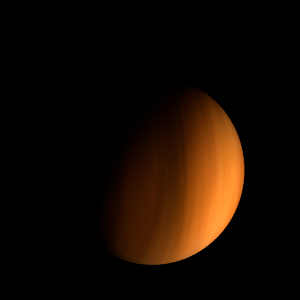|
|
Space Astro
|
Info for exoplanet "Ratebi Zashu"
| Scientific (actual) data |
|---|
| Planet | WASP-18 b |
| Planet status | Confirmed |
| Planet mass | 10.4296 |
| Radius | 1.165 |
| Orbital period | 0.941452 |
| Semi major axis | 0.02047 |
| Orbit eccentricity | 0.0088 |
| Inclination | 86 |
| Angular distance | 0.000205 |
| Discovered | 2009 |
| Updated | 2020-04-17 |
| Omega | 269 |
| Tzero tr | 2454220 |
| Impact parameter | 0.3 |
| Temperature (kelvin) | 2069 |
| Publication | Published in a refereed paper |
| Detection type | Primary Transit |
| Molecules | CO, H, H2O |
| Star name | WASP-18 |
| Right ascension | 24.35° |
| Declination | -45.68° |
| Mag v | 9.3 |
| Star distance | 100 |
| Star metallicity | 0 |
| Star mass | 1.24 |
| Star radius | 1.23 |
| Star sp type | F6 |
| Star age | 0.63 |
| Star temperature | 6400 |
| Wikipedia article | WASP-18 b |
Back
| |
| Fictional info (?) |
|---|
| Suggested name | Ratebi Zashu |
| Planet type | Huge hot gas giant |
| Its orbital period around WASP-18 of 0.94 earth days is the shortest of all the planets in its solar system. It is the second-brightest natural object in the night sky after Kirezu'hera, reaching an apparent magnitude of -5 - bright enough to cast shadows at night and, rarely, visible to the naked eye in broad daylight.
This huge hot gas giant is named after the deity Ratebi Zashu, the demon of dreams.
When viewed from Kirezu'hera, this proximity to WASP-18 means the planet can only be seen near the western or eastern horizon during the early evening or early morning.
The rotational period and seasonal cycles of Ratebi Zashu are likewise similar to those of Earth, as is the tilt that produces the seasons.
Future astrobiology missions are planned, including the Ratebi Zashu 2700 and ExoRatebi Zashu rovers.
This dark place is said to have hostile but poisonous plants, the "Pimazu", which survive only while hunting smaller pray if it is available. Most of them are not related to the Tawahecho but with 8 eyes and vary in length from 60 to 60 meters. The Pimazu are known to survive temperatures from 130 to 240°C and very low gravity. |
| Estimated population | 30000000000 |
| Atmosphere | CO, | 50% |
| H, | 49% |
| H2O | 0.00034% |
| Atmospheric pressure | 3.1 bar |
 |
| Moon | Gyajizu | Large potato shaped rocky comet |
| Zariuba | Large potato shaped rocky asteroid |
| Heheke Byopyu Hyo | Very small irregular oceanic moon |
| Robe-i | Huge slightly egg-shaped oceanic planetoid |
| Ryoro Tsu | Medium-sized round rocky moon |
| Sashayu-gyuga | Medium-sized irregular crater-filled moon |
| Zegipibi Yu | Medium-sized round ice moon |
| Kachi Gyoyu Yuju | Huge potato shaped crater-filled asteroid |
| Pyage-poba-mishi | Medium-sized round rocky moon |
| Zesedabya'watsu | Small slightly egg-shaped ice moon |
| Rinepyu Moihya Ji | Small almost round oceanic moon |
| Shaso-sha | Huge irregular rocky asteroid |
| Nyuse | Huge irregular rocky moon |
| Hesoi'basha-no | Small round rocky moon |
| Pitemo Sajabe Hyu | Large potato shaped rocky moon |
| Puezo Biwa | Small potato shaped rocky moon |
| Shopepyu | Medium-sized almost round rocky asteroid |
| Jibana-chosa Ryo | Large almost round gaseous asteroid |
| Byubu Bipya | Large round rocky asteroid |
| Pozo Tsuru Myo | Very small potato shaped oceanic moon |
| Google search for Ratebi zashu |
|
Website by Joachim Michaelis
|
|
|
|